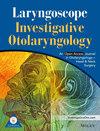Pediatric Hairy Polyp of the Naso-Oropharynx: A Case Report and Systematic Literature Review
Abstract
Introduction
Hairy polyps (HPs), also known as bigerminal choristoma, are rare tumors most often occurring within the nasopharynx and oropharynx, linked to the development of the first and second pharyngeal arches. Commonly, HPs present in female neonates and are left-sided. This case report and systematic literature review provide a comprehensive overview of HPs' presentation, management, and outcomes.
Case Description
A female neonate demonstrated persistent rightward head positioning and gagging at 1 day of life. Oral examination revealed a protuberant tubular soft-tissue mass appearing to originate from the posterior pharynx or nasopharynx. Neck MRI with and without contrast revealed a lobular, exophytic, and pedunculated soft-tissue mass arising from the left soft palate and extending to the oropharynx with minimal post-contrast enhancement. At 3 days of life, she underwent transoral mass resection. Final operative findings revealed a 6-cm mass based on the posterior aspect of the left soft palate near the superior left tonsillar pillar. Histopathological evaluation revealed skin-like epidermis with hair follicles and adnexa surrounding a cartilage core, muscle bundles, fat, and vascular channels consistent with bigerminal choristoma.
Literature Review
Systematic review, conducted according to PRISMA guidelines using PubMed database, yielded 106 published reports with 147 HP cases with a female and childhood-onset predominance. Respiratory distress, feeding difficulties, or a combination of both was the most commonly reported presenting symptoms occurring in 63.9% of cases. Surgical excision is the standard treatment across published reports.
Conclusion
HPs commonly present with respiratory symptoms and a visible mass. Timely diagnosis and surgical intervention are critical to avoid significant complications to the airway and aerodigestive function.
Level of Evidence
4.


 求助内容:
求助内容: 应助结果提醒方式:
应助结果提醒方式:


